There are many different approaches that you can take when you are talking about your organizational strategy. An organizational strategy is very important when you are trying to figure out how you will present your information. I have had experience in some of these organizational strategies and it has been very beneficial to me. I will give you some pointers on how to make the best of whichever organizational strategy you choose.
There are nine different approaches to organizational strategy. They are; sequential, chronological, order of importance, general/specific, division, classification, cause and effect, compare/contrast, and spatial. Each of these nine approaches is beneficial for whatever information you need to present.
“Sequential organization places information in the order that it progresses or should progress.” (Dobrin 175) You are probably wondering where you would see this type of organization. This is seen in all instruction manuals and other documents that require you to go through in a specific order. This is one that I typically don’t follow because it is easier to try and figure it out on your own.
Chronological organizational strategy resembles the sequential strategy. The major difference is that with chronological the events flow through time. They are written as they occur. An example of this that I have written many times is a lab report. You need to write down everything as it happens and then have it flow through the report. I did not realize at the time I was using a chronological organization strategy.
With the “order of importance strategy it is commonly used because it permit’s the writers to present the information in either an increasing or decreasing order.” (Dobrin 177) An example of this strategy would be a memo, or a speech. Both of these use the order of importance, but they use it differently. With a memo you want to put your biggest issue out in the beginning. On the other hand, with a speech you want to save the best for last and go out with a bang.
General/specific strategy is basically going from either general information to specific information or vice versa. This strategy can be beneficial because it allows you to either start out with a very narrow topic and become increasingly broader, or you can start out broad and narrow the topic down. I have used this strategy in formal reports because it allows me to start out with a base amount of background information and then flow into my specific topic.
Division is a strategy “based on the idea that some things can best be understood by treating them as a series of smaller parts.” (Dobrin 179) An example of this strategy would be when you are trying to present information that is part of a large policy. Many politicians will try to divide up a broad topic to allow them to piece it together and make it seem different than it actually is.
Another organizational strategy is classification. This strategy groups similar information together. Some examples could include Dell listing the different types of computers that they offer, or it could be a sports team that is listing it’s players in order. You see this strategy a lot when you look at different products that companies make. It allows you to see all the styles in one simple paper.
“Cause and effect is frequently used to explain the relationships between events or the reasons that something has happened.” (Dobrin 180) We see this everyday when we look at scientific studies. If you look at any over the counter drug bottle it will have the proper directions for taking the medication, but it will also have a list of reasons with what might happen if you misuse the product. This is a cause and effect that many people see everyday and do not even realize it.
Comparison and contrast is a strategy that allows people to see information about two things and decide what each has to offer and what they lack. A personal example for me would be when you are trying to find a job. You want to make sure the company that you work for is a good company and that your values fit in with theirs. You can look at each companies values and mission statement to see which is the best fit for you.
The last organizational strategy is spatial. “Spatial strategy helps readers navigate information pertaining to physical space or objects.” (Dobrin 184) The best example of spatial organizational strategy is when you look at a map. It allows you to see where you are and how you are going to get where you want to go. Most spatial organizational strategies have pictures, but that is not a requirement. The pictures allow us to get a better visual of what the information is saying.
These all the different types of organizational strategy. Hopefully, you have learned a bit about when to use each strategy and that we use most of these strategies in our everyday lives.
Dobrin, Sidney I, Christopher J. Keller, and Christian R. Weisser. "Organizing and Drafting Documents" Technical Communication in the Twenty-First Century (2nd Edition) (MyTechCommLab Series). Alexandria, VA: Prentice Hall, 2009. 170-191. Print.




 Paraphrasing usually deals with a smaller amount of outside material, but
Paraphrasing usually deals with a smaller amount of outside material, but 













 reference:
reference:







 Could cost a candidate his opportunity of the job. Even the smallest error in your resume could suggest to your readers that you are not detail oriented or concerned with quality(pg.409). Even the highest qualified candidates may be eliminated if their resumes or cover letters contain errors. My overall advice when writing a resume would be to assume you cannot afford to make mistakes. Then regardless whether you are the highest qualified, you will have a good shot at landing the job.
Could cost a candidate his opportunity of the job. Even the smallest error in your resume could suggest to your readers that you are not detail oriented or concerned with quality(pg.409). Even the highest qualified candidates may be eliminated if their resumes or cover letters contain errors. My overall advice when writing a resume would be to assume you cannot afford to make mistakes. Then regardless whether you are the highest qualified, you will have a good shot at landing the job.

